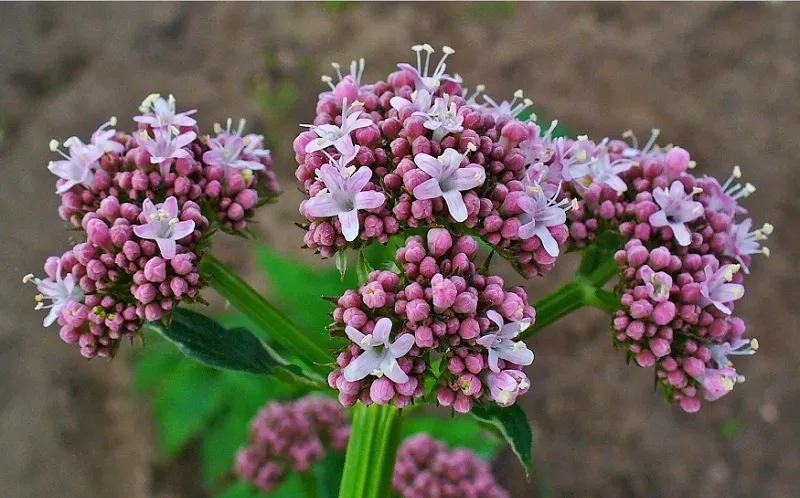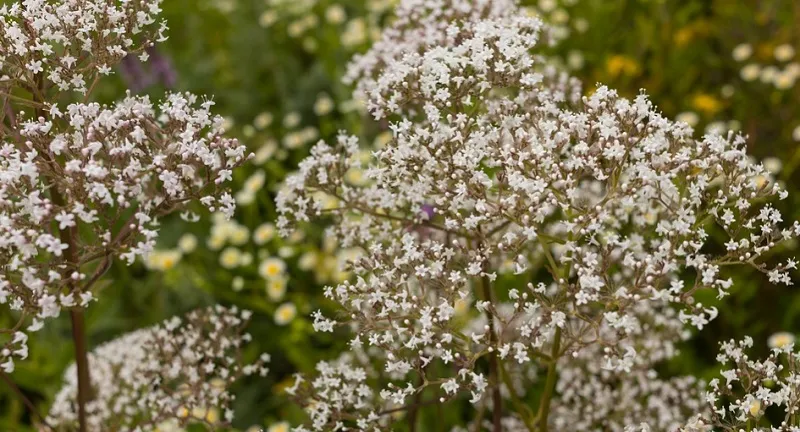Medicinal valerian is a plant that everyone knows about and that is often used to calm the nervous system, but this is far from the only property it possesses.
Valerian medicinal (Valeriana officinalis) is a perennial herbaceous plant of the Valerian family (Valerianaceae) with a short vertical rhizome from which numerous roots depart. The stem is straight, ribbed, hollow inside, up to 1.5 m high. The leaves are oblong, odd-pinnate, with 3-11 linear-lanceolate leaves, large-toothed. The flowers are pale pink, small, fragrant, collected in branched thyroid inflorescences. Fruits are small, flat, brown seeds with a fringe. Blooms from June to August; fruits ripen in August – September.
Chemical composition
Rhizomes with valerian roots contain: essential oil (0.5-2%), free isovaleric acid, borneol, borneol esters with acids (butyric, formic, acetic and others), terpenoids (camphene, limonene, myrtenol, pinene), alkaloid actinidin , valeride glycoside, tannins, sugars, valepotriates.
Useful properties of valerian
Rhizomes with valerian root can be used for the following health problems:
- chronic functional disorders of the central nervous system,
- nervous excitement, neuroses of the cardiovascular system hysteria,
- acute disorders due to mental trauma,
- migraine, insomnia, angina, heart pain, epilepsy (in combination with other medicinal products),
- stage I hypertension, extrasystole, paroxysmal tachycardia, acute myocarditis,
- climacteric disorders;
- stomach neuroses, disorders of the secretory function of the glandular apparatus of the gastrointestinal tract,
- spasm of the esophagus, diseases of the liver and biliary tract in complex therapy.
In dermatology, you can use valerian preparations for atopic dermatitis, true and microbial eczema, erythroderma, skin itching, psoriasis, and urticaria. Rhizomes and roots of valerian are part of collections, teas, and biologically active supplements.

When stored, the seeds deteriorate quickly, and they should be used in the year of collection: that is, collected in the summer, sown the following spring.
Care with medicinal valerian
If old seeds got to you, they will not have a mass descent. Even two-year-old seeds make sense to sow more densely. Care in the summer is quite simple. This is watering when the soil dries out (valerian is drought-resistant, but to get good rhizomes you need constant moisture), this is fertilizing 2-3 times per season with a solution of mineral fertilizers, loosening between the rows until the bushes close. Only in the second year of the plant’s life, where it is grown to obtain a root, during the flowering phase, the peduncles are removed (creaming). Creaming do not perform on the seeds.
Collection of plant
The peduncles cut twice at a height of 15 cm from the soil surface. Root digging begins in September – October. Wash the roots, the above-ground part remove, the thick rhizomes cut in a cross shape, dried for 1-2 days and dry at a temperature of 40-45 °C.
The dry root yield is from 150 to 300 g/m2. Start collecting when the general color background of the area becomes yellowish-green. This happens approximately on the 15-17th day after mass flowering. We cut the seeds, tie them in small bundles, place them under a canopy with good ventilation and thresh them on the 5-7th day. Seed yield up to 10 g / m2. The shelf life of the dry root is three years.
How to make a valerian drink
It is necessary to take valerian root and grind it so that it turns out about two teaspoons. Next, pour the chopped root with a glass of clean, cool water and let it infuse. It is necessary to periodically stir, the drink will be completely ready in 12 hours. The daily norm will be about two or three cups.
Also take two teaspoons of finely chopped valerian root and pour half a liter of boiling water. Close the dish tightly and let it infuse for ten minutes. Prepare a fresh drink every time as it can spoil. You can mix valerian roots with lemon balm leaves. Pour two spoons of the herbal mixture with a glass of boiling water and insist for 15 minutes.

